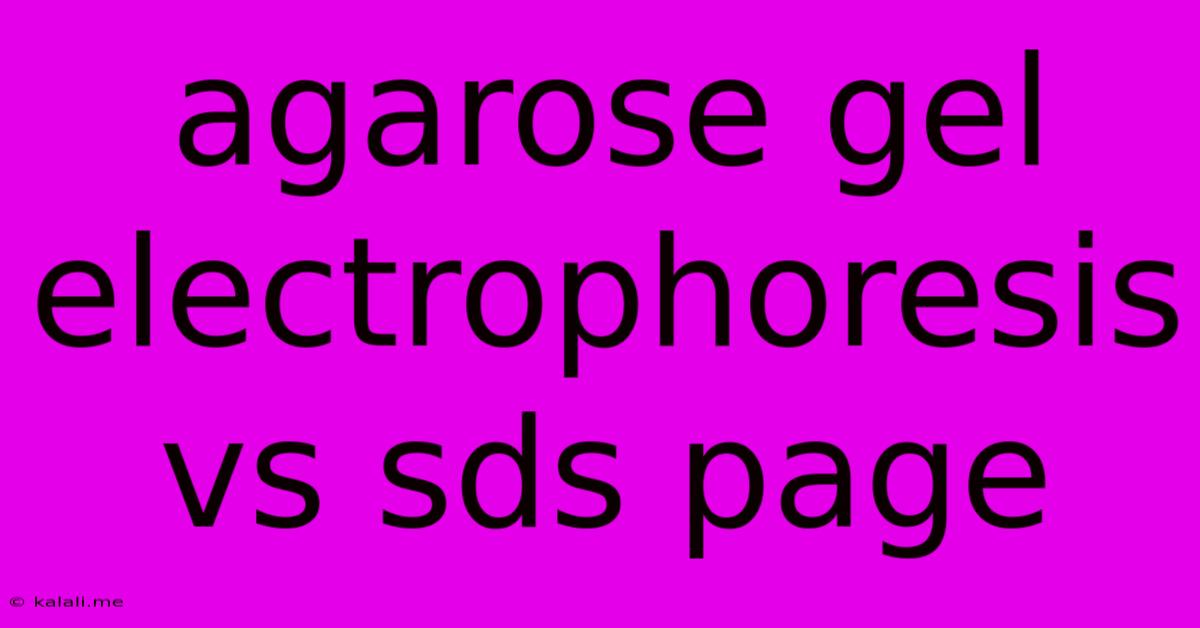Agarose Gel Electrophoresis Vs Sds Page
Kalali
Jun 13, 2025 · 3 min read

Table of Contents
Agarose Gel Electrophoresis vs. SDS-PAGE: Choosing the Right Technique for Protein and Nucleic Acid Separation
Choosing the right electrophoretic technique is crucial for successful molecular biology experiments. Two widely used methods are agarose gel electrophoresis and SDS-PAGE (sodium dodecyl sulfate polyacrylamide gel electrophoresis). While both separate molecules based on size and charge, they are optimized for different types of molecules and provide distinct advantages and disadvantages. This article will delve into the key differences between these two techniques, helping you determine which is best suited for your specific needs.
Meta Description: This article compares agarose gel electrophoresis and SDS-PAGE, highlighting their differences in application, resolving power, and the types of molecules they separate, aiding researchers in selecting the appropriate technique.
Agarose Gel Electrophoresis: Ideal for Nucleic Acid Separation
Agarose gel electrophoresis is a widely used technique primarily for separating nucleic acids such as DNA and RNA. It employs a gel matrix composed of agarose, a polysaccharide derived from seaweed. The agarose concentration determines the gel's pore size, influencing the separation resolution. Lower concentrations (0.5-0.8%) are suitable for separating larger DNA fragments, while higher concentrations (1-2%) are better for resolving smaller fragments.
Advantages of Agarose Gel Electrophoresis:
- Simplicity and ease of use: The procedure is relatively straightforward and requires less specialized equipment compared to SDS-PAGE.
- Cost-effectiveness: Agarose is inexpensive, making this technique budget-friendly.
- Wide range of applications: Suitable for separating DNA fragments of various sizes, from kilobases to hundreds of base pairs. It's used in DNA fingerprinting, cloning, PCR product analysis, and plasmid analysis.
- Visualization: DNA and RNA can be easily visualized using ethidium bromide or other DNA-intercalating dyes under UV light.
Disadvantages of Agarose Gel Electrophoresis:
- Lower resolution: Compared to SDS-PAGE, it offers lower resolving power, especially for smaller DNA fragments.
- Limited applicability to proteins: Though possible, agarose gel electrophoresis is not ideal for protein separation due to its relatively large pore size.
SDS-PAGE: High-Resolution Protein Separation
SDS-PAGE (sodium dodecyl sulfate polyacrylamide gel electrophoresis) is a powerful technique for separating proteins based primarily on their molecular weight. The gel matrix is composed of polyacrylamide, providing finer pore size control and higher resolution compared to agarose. SDS, a detergent, denatures proteins, giving them a uniform negative charge, ensuring separation is based solely on size.
Advantages of SDS-PAGE:
- High resolution: Provides superior resolution compared to agarose gel electrophoresis, capable of separating proteins differing by even a few kilodaltons.
- Precise molecular weight determination: By comparing the migration of proteins to known molecular weight markers, accurate molecular weight determination can be achieved.
- Wide range of applications: Used in various applications, including protein purification, analysis of protein mixtures, and assessing protein expression levels. Western blotting often follows SDS-PAGE.
Disadvantages of SDS-PAGE:
- Complexity and longer procedure: The preparation of the polyacrylamide gel is more complex and time-consuming than agarose gel preparation.
- Higher cost: The chemicals and equipment needed for SDS-PAGE are generally more expensive.
- Denaturing conditions: SDS denatures proteins, which may not be suitable for analyzing protein structure or conformation. Native PAGE is needed for this.
Choosing the Right Technique: A Summary Table
| Feature | Agarose Gel Electrophoresis | SDS-PAGE |
|---|---|---|
| Molecule Type | Nucleic acids (DNA, RNA) | Proteins |
| Resolution | Low | High |
| Complexity | Simple | Complex |
| Cost | Low | High |
| Applications | DNA fingerprinting, cloning | Protein purification, Western blotting |
Ultimately, the choice between agarose gel electrophoresis and SDS-PAGE depends on the type of molecule you are analyzing and the required resolution. For nucleic acid separation, agarose gel electrophoresis is the preferred method. For high-resolution protein separation and molecular weight determination, SDS-PAGE is the technique of choice. Understanding the strengths and limitations of each method is essential for obtaining accurate and reliable results in your molecular biology experiments.
Latest Posts
Latest Posts
-
Chondrocytes Are Found In Cavities Called
Jun 14, 2025
-
Average Sat Score For University Of Colorado Boulder
Jun 14, 2025
-
1 Bar Is Equal To How Many Pascal
Jun 14, 2025
-
What Is Estimation In Civil Engineering
Jun 14, 2025
-
Least Common Multiple Of 4 8 And 10
Jun 14, 2025
Related Post
Thank you for visiting our website which covers about Agarose Gel Electrophoresis Vs Sds Page . We hope the information provided has been useful to you. Feel free to contact us if you have any questions or need further assistance. See you next time and don't miss to bookmark.